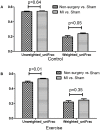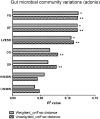Moderate-Intensity Exercise Affects Gut Microbiome Composition and Influences Cardiac Function in Myocardial Infarction Mice
- PMID: 28919891
- PMCID: PMC5585143
- DOI: 10.3389/fmicb.2017.01687
Moderate-Intensity Exercise Affects Gut Microbiome Composition and Influences Cardiac Function in Myocardial Infarction Mice
Abstract
Physical exercise is commonly regarded as protective against cardiovascular disease (CVD). Recent studies have reported that exercise alters the gut microbiota and that modification of the gut microbiota can influence cardiac function. Here, we focused on the relationships among exercise, the gut microbiota and cardiac function after myocardial infarction (MI). Four-week-old C57BL/6J mice were exercised on a treadmill for 4 weeks before undergoing left coronary artery ligation. Cardiac function was assessed using echocardiography. Gut microbiomes were evaluated post-exercise and post-MI using 16S rRNA gene sequencing on an Illumina HiSeq platform. Exercise training inhibited declines in cardiac output and stroke volume in post-MI mice. In addition, physical exercise and MI led to alterations in gut microbial composition. Exercise training increased the relative abundance of Butyricimonas and Akkermansia. Additionally, key operational taxonomic units were identified, including 24 lineages (mainly from Bacteroidetes, Barnesiella, Helicobacter, Parabacteroides, Porphyromonadaceae, Ruminococcaceae, and Ureaplasma) that were closely related to exercise and cardiac function. These results suggested that exercise training improved cardiac function to some extent in addition to altering the gut microbiota; therefore, they could provide new insights into the use of exercise training for the treatment of CVD.
Keywords: 16S rRNA; cardiac function; exercise; gut microbiome; myocardial infarction.
Figures








References
-
- Alverdy J., Zaborina O., Wu L. (2005). The impact of stress and nutrition on bacterial-host interactions at the intestinal epithelial surface. Curr. Opin. Clin. Nutr. Metab. Care 8 205–209. - PubMed
-
- Branchereau M., Reichardt F., Loubieres P., Marck P., Waget A., Azalbert V., et al. (2016). Periodontal dysbiosis linked to periodontitis is associated with cardiometabolic adaptation to high-fat diet in mice. Am. J. Physiol. Gastrointest. Liver Physiol. 310 G1091–G1101. 10.1152/ajpgi.00424.2015 - DOI - PubMed
LinkOut - more resources
Full Text Sources
Other Literature Sources

